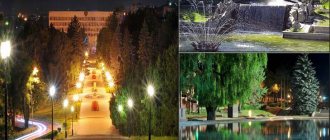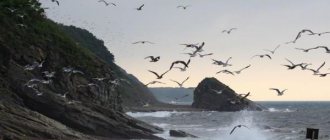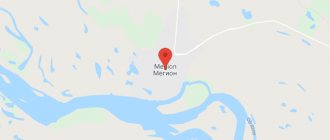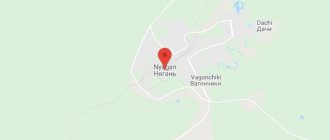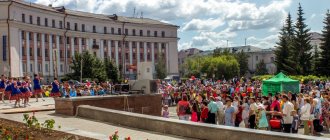Using a satellite map of Dzhankoy, you can view the location of the modern city, find neighboring settlements, and get an idea of the terrain and natural objects that surround the settlement.
Currently, Dzhankoy is an industrial city with a population of more than 30 thousand people. The location of plants and factories can be seen on the map of Dzhankoy with diagrams. The city also has an airport, which is located on the southeastern outskirts, a bus station and a railway station. The Mirnovka and Stepnaya rivers flow through the entire city. These are shallow and non-navigable hydraulic objects that flow into the North Crimean Canal.
As the map of Dzhankoy with districts shows, the city is territorially divided into microdistricts:
- Land reclamation;
- Canning factory;
- Industrial;
- Military City;
- Carleuth;
- Center.
Maps allow you to view the infrastructure of each area, find out whether it has schools, kindergartens, businesses, and entertainment. It is convenient to travel with Yandex maps of Dzhankoy. They can become a real helper for those who come to this city for the first time or are poorly oriented in the locality.
Current statistics
The Republic of Crimea (Crimean Federal District) is part of the Russian Federation. When talking about current statistics regarding the population living on these lands, they take into account not only the territory of the Republic itself, but also the city of Sevastopol, which has a special status.
Rosstat data show that as of January 1, 2022, 1,912,622 citizens live in Crimea (district), while in Sevastopol there are about 500 thousand inhabitants. The total population of the Republic of Crimea is 2,360,000 inhabitants. For comparison, in 2022, 1,912,775 people lived in the Republic of Crimea (about 20 more people in 2022).
The most interesting places in Dzhankoy
The main attractions of Dzhankoy are several monuments dedicated to the feat of soldiers who gave their lives for the liberation of Crimea during the Great Patriotic War. The monument to the unknown pilot is especially interesting. The stern figure of an aviator in military uniform against the background of a three-bladed propeller
is a reminder to everyone living today about the bloody battles that took place here.
It is definitely worth spending a few hours and making a half-hour journey to the village of Aleksandrovka, which is located 30 km from the city. The very beautiful Church of the Heart of Jesus Christ is located here. The building of the temple complex, built at the beginning of the last century, is a wonderful example of neo-Gothic architecture. Its inspection will leave a pleasant impression, delighting you with excellent views.
Interesting places have always been the key to a successful holiday in Crimea. Dzhankoy pleases travelers with another historical monument that needs to be seen in the surrounding area - this is the estate of the landowner Shatilov in the village of Tsvetushchee (Nizhnegorsky district). Several buildings and structures have been well preserved; examining them will tell you a lot about the trends in Russian architecture of the late 19th century. Truly this is a great place for a pleasant leisure time.
Data by year
Since 2014, since the annexation of Crimea to the Russian Federation, the number of residents living in this territory has remained relatively stable, having increased slightly, apparently due to immigrants from other regions of Russia, only in the last 2-3 years. If you look specifically by year, then a person interested in such information will see the following picture:
- 2014 – 1884473.
- 2015 – 1901511.
- 2016 – 1909637.
- 2017 – 1912950.
- 2018 – 1912775.
Moreover, if we compare the number of rural and urban residents, we will have to note that their number is approximately equal. The city has barely 5,000 more inhabitants than the countryside. This is quite a small difference.
List of cities
There are 17 cities with a population of over 5,000 people on the peninsula. Moreover, 14 of them have a population of over 15,000 people. Largest cities:
- Simferopol. Over 342,000 inhabitants. The capital of the Republic of Crimea, located on the Salgir River. In terms of population, it ranks 57th among other Russian cities. In Simferopol, directly within the city, 94% of the total population of the Simferopol urban district lives. The most important transport hub of Crimea is located here, which has a direct impact on migration processes, population loss and profit.
- Sevastopol. Over 443,000 inhabitants; for comparison, in the year of foundation (1790), only 193 people lived in the territory of the future Simferopol, and after the war (1946 census) no more than 56,000 people. A sharp influx of people occurred in the next decade; in 1959, 148,000 people already lived in the city, and in 1967 - 209,000 citizens. The mark of 300,000 was reached by 1979. A sea trade and fishing port on the Black Sea coast, the location of the Russian Black Sea Fleet, a federal city. In terms of population, Sevastopol is in 43rd position among other large cities of the Russian Federation (for the census it was compared with another 1115 cities). About 393,000 residents live permanently in the city, most of whom recognize themselves as Russian by nationality, while Ukrainians in the city make up at least 14%.
- Kerch. A large commercial and industrial center with a population of 151,000 people, it ranks 118th in the sample of large Russian cities. River and sea port. The growth dynamics are not so significant when compared with Simferopol and Sevastopol. Thus, the city became a city with a population of 100 thousand back in 1939, while 20 years later only 98,000 residents live in Kerch, most of whom are Russian by nationality. The predominance of Russians was and remains one of the main features of Kerch.
- Evpatoria. The fourth most populous city on the peninsula. Over 105,000 people live here, and since the city is a resort, the same number come here during the season. As a result, almost 200,000 people live in Yevpatoria in the summer.
- Yalta. About 80,000 people live here permanently, with about 500,000 tourists coming on vacation in the summer.
Feodosia, Dzhankoy, Alushta, Bakhchisarai with a population of 26 thousand or more are considered large cities.
Where is the city of Dzhankoy
The city is located in the north of Crimea. The place where the city of Dzhankoy is located has long been called the northern gate of the Crimean peninsula. The Dzhankoy railway junction played an important role in the life of the republic before the transport blockade by Ukraine, and after the launch of trains on the Crimean Bridge it continues to do so.
There is no sea in the vicinity of Dzhankoy, which is part of the Autonomous Republic of Crimea. But the Crimean steppe spreads around. And the Stepnaya River flows through the city itself. However, it’s not that far to get to the sea, even two of them: to Chernoe - 60 km, to Azov - 135 km. Travel companies in the city of Dzhankoy are ready to organize excursions to anywhere in the Crimean region. There is a lot of sun and warmth here - the southern summer is hot, dry and long. Summer temperatures in the territory where Dzhankoy is located in Crimea do not fall below +24⁰. High hills protect the city from gusts of steppe winds.
Information about the Republic
As a subject of the Russian Federation, the Republic of Crimea belongs to the Southern Federal District and the North Caucasus economic region. The date of formation is considered to be March 18, 2014. It was on this day that the Crimean Peninsula was officially annexed to Russia, leaving the control of Ukraine, of which it was once a part. The international community denies the annexation of Crimea to Russia, considering this territory as part of Ukraine.
Local residents are mainly involved in various industries, construction, healthcare and trade. Tourism and agriculture are well developed. The mild climate makes the Black Sea coast attractive to tourists from all over Russia. Sea and river ports make it possible to deliver products produced here to anywhere in the world.
Details
Interesting Facts
* Translated from the Crimean Tatar language into Russian, Dzhankoy translates as “sweet village”.
* Due to the geographical location of the city and developed transport infrastructure, Dzhankoy is called the gateway to the Crimean Peninsula.
* The city of Dzhankoy is famous for the ability of local residents to make delicious and exquisite wines according to special Greek recipes.
Sights of Dzhankoy
* Local History Museum
Located in the city of Dzhankoy, on Karl Marx Street. The museum opened three times - in 1968, was closed in the 1990s, in 1997, was closed in 2010 and in 2015 - and is still open today.
Tourists can visit the local history museum for free. In the museum you can see archaeological, historical, ethnographic and military exhibitions. The museum's collection includes 1,136 exhibits.
* Monastery of Christ the Savior
This attraction of Dzhankoy is very popular among tourists. In past times, there was a Christian settlement on the site of this monastery.
Nowadays the abbot and four monks live on the territory of the monastery. You can get into it along several paths - from the valley or from the mountain. Be polite - before visiting the monastery, be sure to ask permission from the abbot.
* Intercession Cathedral
Located in Dzhankoy, on Luxembourg Street. The temple was built in 1990, not far from the old Intercession Church.
There is a Sunday school for children at the church, and spiritual and educational events are constantly held - Orthodox holidays, meetings and quizzes. The Divine Liturgy is served daily, and hierarchal services are performed.
* Dzhankoy-Jami Mosque
Located on Sovkhoznaya Street. The mosque is a small, white building with one minaret. It plays a great role in the lives of the townspeople, since many of them are Muslims. In the summer, a children's camp operates at the mosque. In it, children learn the basics of Islam.
* Lake Sivash
The lake is located in the Dzhankoy district, along the border of Crimea with Ukraine. These are steppe areas devoid of vegetation. The lake is famous for its beautiful landscapes and healing lake silt. Some Crimean sanatoriums and boarding houses use this sludge for medicinal purposes.
* Monuments of Dzhankoy
~Holocaust Monument
Located on Krymskaya Street. It is a stone wall, with the silhouette of a woman with a burning candle.
During the war, in 1942, tragic events took place here - the Nazis carried out the execution of communists, Jews and prisoners of war. About 7 thousand people were executed.
~ Monument to the liberators of the city
Located on Oktyabrskaya Street. Installed in honor of the soldiers of the 19th Tank Corps who liberated Dzhankoy in 1944. The monument is a tank mounted on a pedestal.
~ Monument to Aviators
Installed on Nesterov Street in honor of military pilots of all times. It is a sculpture of a man in a flight suit, mounted on a pedestal, with his arms thrown up, against the backdrop of an airplane propeller.
~Brotherly Cemetery
Located on Krymskaya street. This mass grave is the same for soldiers, civilians, underground fighters, partisans and prisoners of war who fell during the war. Next to the brotherly cemetery there is a monument to the soldiers who died in the prisoner of war camp.
Kalinovsky Nature Reserve
The reserve is a landscape park. It was created with the aim of preserving a natural landscape uncharacteristic for the peninsula—wetlands. It can be visited freely. There is no tourist infrastructure in the reserve. A visit to these places will interest nature lovers. It is home to over 100 different species of birds and many beautiful landscapes.
National composition
The predominant nation is Russians - over 62%, followed by Ukrainians - more than 14%. Approximately 12% of the total are Crimean Tatars. Also found:
- Tatars.
- Belarusians.
- Armenians.
- Azerbaijanis.
- Uzbeks.
- Koreans.
- Greeks.
- Moldovans.
- Jews.
In small numbers, immigrants from Germany, Poland, Tajikistan, Georgia, Turkey, and Bulgaria are registered. Gypsies, Krymchaks, Chuvashs, Mordovians, Maris and Karaites live here. Moreover, even in the first quarter of the 18th century, 95% of all inhabitants of the peninsula were Tatars and only a small few percent were Greeks, Armenians, Karaites and Crimeans. Closer to the middle of the century, Armenians, and not Russians or Ukrainians, were the second largest people in Crimea. Changes began to appear towards the end of the 18th century. Already in 1864, only a little more than 50% of Crimean Tatars and 28.5 Russians and Ukrainians would live here.
In official documents of our time, citizens can speak three languages - Russian, Ukrainian and Crimean Tatar, but over 80% of respondents who participated in the 2014 census indicated that they speak exclusively Russian.
Where to stay
The city hosts several fairly large and comfortable hotels:
- “Chocolate” is the best hotel in the city, designed to accommodate 50 people at a time, who, in addition to standard single and double rooms, can choose temporary luxury and junior suite accommodation. Room cost from 2000 rubles. Regardless of the price, each room is equipped with a private bathroom, air conditioning, and wireless Internet. The local restaurant serves dishes of Russian, Ukrainian, and Tatar national cuisines. There is a bar. A guarded parking lot is provided. “Tavria” - the hotel is located in the very center, next to the railway station, each of the 80 rooms is equipped with a shower room, a split system, guests have a TV and Internet access.
- “Karpaty” - guests of the city pay tribute to the hotel for its traditional range of amenities. Additional advantages include free parking and a convenient location near the highway leading to Simferopol.
- “The Tsarskoye Podvorye” is the most elegant hotel in the city, but with a modest number of rooms it offers more comfortable conditions: in addition to the standard set of amenities, the apartments of the small hotel are equipped with an additional guest room with furniture.
- "Elbrus" is the newest hotel in the city with rooms equipped with a standard set of amenities. Nearby is the Lakomka cafe, which offers a good menu.
Gender and age
Approximately the same number of men and women are constantly present on the territory of the peninsula. Thus, about 204 thousand males and 231 thousand females live in Sevastopol. At the same time, the percentage of people of retirement age is about 27%, slightly less than children under 16 years old – 16.5%.
The average life expectancy is 73-74 years, while the average age is 40.7-40.8 years.
Marriages and divorces
Rosstat data show that the number of officially registered marriages in relation to the total number of citizens is decreasing every year. So, if in 1990 20,541 marriage records were registered, which amounted to 9.7 (per 1 thousand people), then in 2018-2020. Just over 11,000 marriages were registered annually. The coefficient dropped to 6-6.5.
2019 data
Men, like women, most often get married at the age of 25-34, but the percentage of women who decide to get married at 18-24 is also high, twice as high as the same figure for men in the same age group – 3500-4000 women for 1900-2000 men. A large number of marriages take place after 35 years. Early marriages are gradually becoming obsolete. If in 2000 - 2001. Before turning 18, 561 women formalized relationships; in 2022 there were only 50 such women, and in 2022 even less.
Of the 11,000 marriages concluded, approximately 6-7 thousand break up. This figure does not change from year to year. The lowest number of divorces was recorded in 2012-2013. During this period, the divorce rate was 1.2 and 1.1 compared to the current 3.5.
Migration
Since 2004, statistics have reported a positive balance of migration. Since 2014, residents of the peninsula have been actively leaving their homes, leaving temporarily or for permanent residence in other regions of the Russian Federation, mainly in capital cities, the Moscow region and the Krasnodar Territory; the outflow of the population is associated with the search for work, a more favorable climate and a place for children to study . Part of the rural population moved to Sevastopol.
Forecast
In general, the Republic is not threatened by a migration collapse; the population remains at a consistently high level, which allows indigenous residents to feel quite comfortable at home, and tourists to enjoy a good holiday on the Black Sea coast.
The Crimean Peninsula, including Sevastopol, is part of the territory of the Russian Federation, annexed in 2014 as a result of a referendum. The population is mainly Russian. Crimean Tatars and Ukrainians, representatives of other nationalities also live here. They speak Russian, Crimean Tatar and Ukrainian. They profess Orthodoxy and Islam.
How to get there
Getting here is not difficult. Since this is the main railway junction of the peninsula and all trains on their route pass through this city. Highways connecting the northern part of Crimea with Kherson and Feodosia also pass through it.
From Moscow it is most convenient to fly to Simferopol, and then the remaining 93 kilometers by any means of transport: regular bus, train, minibus.
It may seem to you that Dzhankoy is far from luxury resorts, but, like a true Crimean, he cordially shares what he has. And there is not so little: inexpensive vacation, the opportunity to improve your health, enjoy the gifts of southern nature
0 0 votes
Article rating


